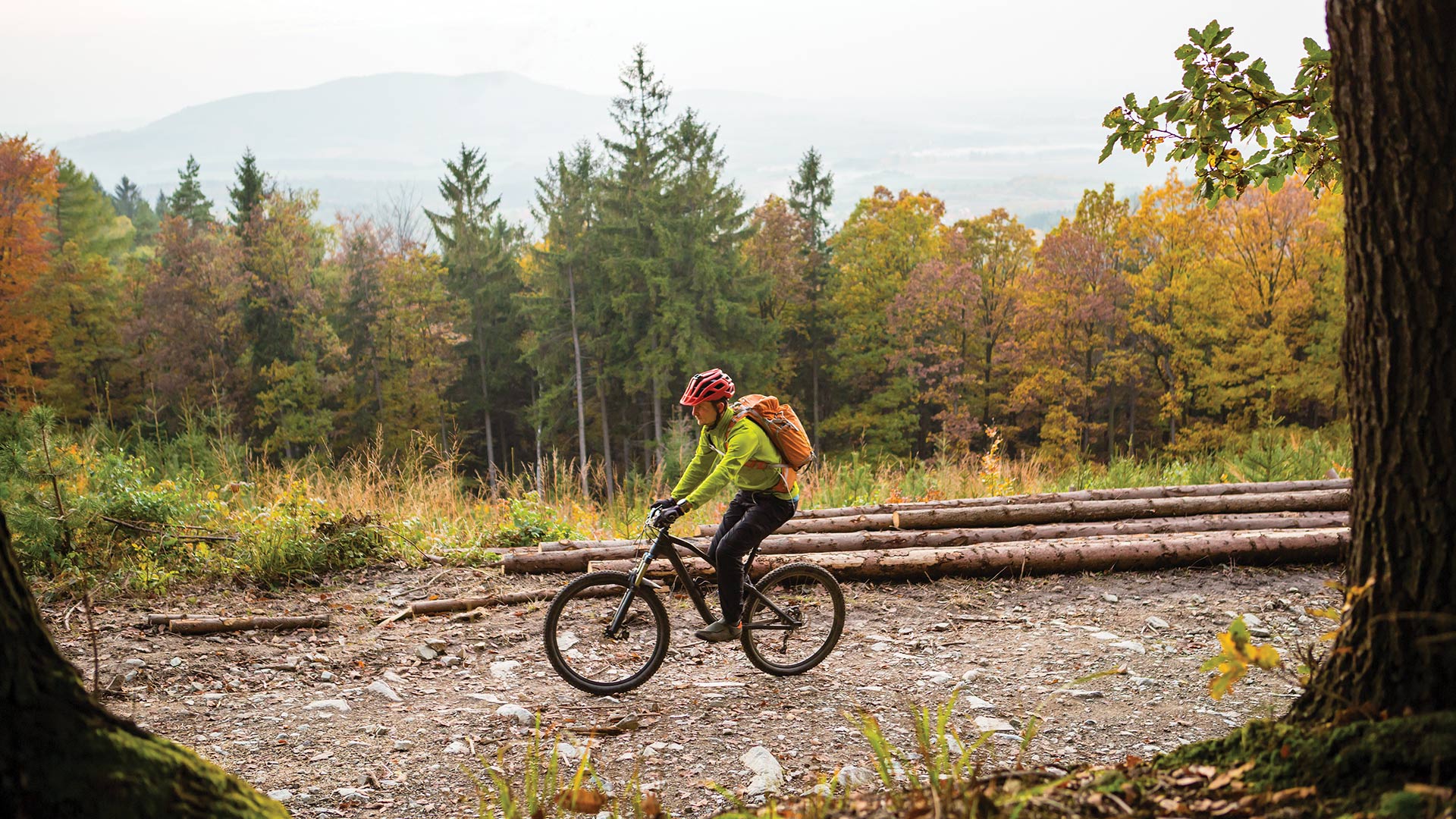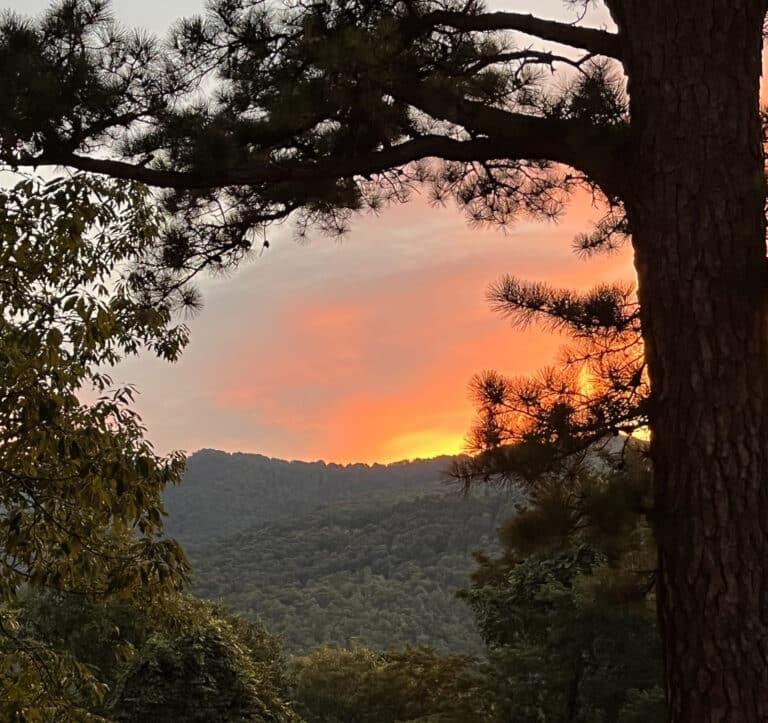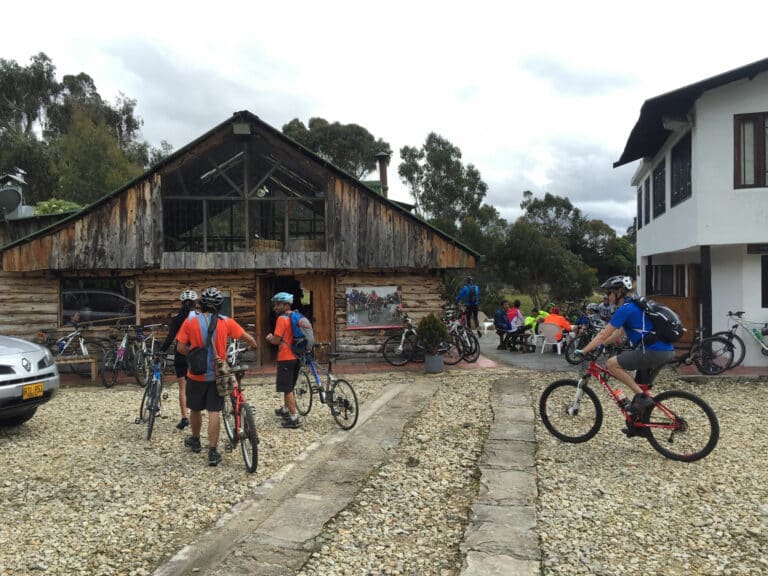It took Barrett Dodds—straddling a mountain bike at the trailhead of some of Pisgah National Forest’s most iconic tracks—just a few minutes to come around to the conventional view.
He wasn’t crazy about the idea of paying to ride in Pisgah, he says at first. It’s a forest, not a bike park. He doesn’t like trails groomed like Disney rides, and raw, rugged terrain is “what makes Pisgah such a gem.”
But then Dodds’ riding buddies pointed out that even natural trails can become too rocky and rutted for good riding, that such conditions promote the erosion blamed for clouding mountain creeks and rivers, and that the rangers’ tiny maintenance budget must accommodate a flood of users like them: out-of-town mountain bikers who have come to think of Pisgah almost like the holy ground it’s named after.
“I guess I wouldn’t be highly against it,” concludes Dodds, 24, a registered nurse who drives from Greenville, S.C. at least once a week to ride in Pisgah. “With destination status comes a lot of wear and tear on the trails.”
The idea of levying fees for mountain bikers and equestrians in Pisgah Ranger District slipped out at a meeting in November. It landed less as a bombshell than as a plea from a favorite charity. The forest needs us, the users say. Of course we’ll give.
But they should also be aware of the broader view, say environmentalists. They see the growing dependence on user fees—Pisgah Ranger District is one of 35 sites of possible new or increased fees in National Forests in North Carolina alone—as cover for decades of misguided spending priorities by federal lawmakers and Forest Service managers.
Too much goes to promote logging, which is ultimately a loser for taxpayers, and to fighting fires, some of which should just be allowed to burn, they say. Too little goes to creating sustainable, inviting forests for hikers, climbers, paddlers, hunters, anglers, cyclists and horse riders—the recreational users who not only make up the bulk of forest visitors, but who, by far, create the most jobs and pump the most cash into surrounding communities.
“Recreation needs are going to continue to be shortchanged by fire funding and road maintenance that supports logging, unless and until Congress does its job,” says Sam Evans, a lawyer with the Southern Environmental Law Center. “I don’t think that fees are inevitable, and I don’t even see that they are necessarily desirable.”
Evans is at least partly right, says David Casey, the head ranger of the Pisgah Ranger District, the popular 171,000-acre block of forest west of Asheville. The fee program he’s considering is far from inevitable—not even a formal proposal at this point, he wrote in an emailed response to questions, but a “concept.” It faces an exhaustive review process, including public comment. And if the district does start charging users, the collection and spending of this revenue is strictly limited by federal law, especially the 2004 Federal Lands Recreation Enhancement Act.
Entry fees for national forests, unlike for national parks, are forbidden, so nobody needs to worry that Pisgah’s famous stone gateway will suddenly sprout a toll booth.
The decades-long practice of charging for campgrounds, however, is allowed under the act. So is levying fees for day-use sites such as the Sliding Rock swimming area. And though the Forest Service cannot collect fees from hikers in general, the same provision enables the Forest Service to impose fees at popular hiking trailheads, such as Whiteside Mountain in the Nantahala National Forest.
The possible fees for mountain bikers and equestrians would be allowed by the same provision that enables the agency to charge $5 daily or $30 annually for ATV riders at the Brown Mountain OHV (off-highway vehicle) Area; all are considered “specialized uses,” which include activities that require specific trail designs, Casey wrote.
The act also requires that money collected goes not to the federal Forest Service budget but to local improvements: habitat restoration, shoring up trails and access roads, building information kiosks, paying law enforcement officers.
And though nobody has set a fee amount, it should certainly be within the budgets of its targets, says Rick Calvert, an officer with the Backcountry Horsemen of North Carolina.
“I think if you can afford a mountain bike or a horse, you can afford a $30-a-year fee,” he says.
It’s especially reasonable, a wide variety of users say, considering the clear need.
A comparison of two recent nationwide Forest Service user surveys in 2011 and 2015 shows a 42 percent increase in park visitors who called mountain biking their primary activity. Closer to home, mountain bikers visit Nantahala and Pisgah forests 435,000 times per year, according to a 2017 report by the Outdoor Alliance.
And though Forest Service surveys show modest growth in horse riding, it’s booming in Mills River, where the overflow of horse trailers in parking lots regularly spills out onto a popular access point, Turkey Pen Road, Calvert said. Meanwhile, the peak-season jam of trucks and cars—many of them carrying mountain bikes—sometimes extends more than a mile back from the park exit on U.S. 276 near Brevard, says veteran mountain biker Wes Dickson.
“Five years ago, you could drive right out of the forest on a Saturday. Now it’s backed up to the Ranger Station,” says Dickson, 41, owner of two Sycamore Cycles bike shops near Pisgah. “We’re seeing increased traffic in the shops. We’re seeing increased traffic on the trails.”
Just as obvious is the rangers’ struggle to manage the impact of all users—too few bathrooms and too few clean ones, law enforcement stretched too thin to stop illegal, trash-dumping roadside campers or to make Dickson feel at ease when he sees his wife set off for a trail run—and the impact specific to mountain bikers and equestrians.
The condition of Turkey Pen is “horrible … it’s in need of major repair,” says Tom Thomas, the Backcountry Horsemen’s statewide president, who added that some nearby, washed-out stretches of trail have been reduced to little more than webs of exposed roots. Pisgah’s trails are prone to such erosion because many of them were built by loggers for direct access and without switchbacks to divert water flow. The silt and sand carried by such degraded trails and other sources “is probably the number one pollutant of mountain streams,” says Andrea Leslie, a biologist with the North Carolina Wildlife Resources Commission.
“A healthy mountain stream has clean gravel and clean boulders,” which are needed to support healthy populations of salamanders, trout and the insects they feed on, she says. “Sediment can bury habitat.”
Jeff Furman, a guide with Davidson River Outfitters in Brevard, watches it happen after every heavy rain.
“Even 10 years ago, the Davidson River would get a little dingy for four to eight hours at the most,” he says. “Now it’s like one or two days, and it gets so dirty you can’t see the bottom of the river. I mean, it looks like chocolate milk.”
Anglers, through license fees and equipment taxes, pay for restoration work in the forests, he says. So should cyclists.
“They’re able to do whatever they want out there, without having to contribute any money to save the forest.”
Mountain bikers and horse riders do pay, they say. The Backcountry Horsemen and Pisgah Area Southern Off-Road Bicycle Association (SORBA) contribute thousands of volunteer hours and a vast majority of the trail work in Pisgah.
Since 2013 SORBA has raised $423,000 in grant money for trail improvements, including the recent, highly praised reconstruction of Pisgah’s Lower Black Mountain Trail. Mountain bikers also drop about $30 million per year into the local economy during visits to Nantahala and Pisgah, according to the Outdoor Alliance report, and combined with paddlers and rock climbers create a total annual economic impact of $115 million. Figure in the impact of other outdoor enthusiasts, and the contributions are even more dominant. Of the 4,950 jobs created or supported by national forests in North Carolina, according to a 2014 Forest Service report, nearly 4,000 could be tied to recreational opportunities.
The idea of adding user fees to recreationists’ current contributions of cash, labor and economic impact might give them another reason to get on board with the fee program: political clout.
“If you want to have a seat at the table,” says Andy Stahl, executive director of the non-profit Forest Service Employees for Environmental Ethics, “it helps to say we pay the freight.”
Too often, the Forest Service, or at least the lawmakers that help determine its funding, seem stuck in the days when forest town were built around timber and paper mills while they now serve primarily as “recreation gateways,” Evans says. “Is the overall budget mix disproportionally skewed to the timber industry? The answer is an absolute yes.”
“Recreation needs are going to continue to be shortchanged by fire funding and road maintenance that supports logging, unless and until Congress does its job.” —Sam Evans, attorney, Southern Environmental Law Center
Harnessing the political power of recreational users and agreeing how to direct it is notoriously tricky. Different users favor different management policies. National forests contain greatly divergent ecosystems and are surrounded by a wide variety of development patterns. And even full-time naturalists emphasize varying approaches to two of the Forest Service’s main traditional operations, selling timber and fighting fires.
But Chad Hanson, co-founder of the John Muir Project, speaks for many environmentalists when he argues for more fire and less fire fighting.
In the early 20th century, he said, fire consumed as much as 30 million acres of the nation’s woodlands, which means that the 10.1 million acres that burned in 2015 was not, as is frequently claimed, a record.
“It wasn’t even close,” Hanson says.
Fires, even ones that destroy mature trees, are a natural reboot for aging, fuel-clogged forests, he said. And hunters, who are often allied with logging interests because of their preference for open, clear-cut landscape, he said, would find that fire leaves similar “early successional” landscape, except that it’s far richer in wildlife.
Unlike logging, fire doesn’t leave debris—essentially “kindling,” Hanson says—that renders forests more vulnerable to future fires. And it doesn’t require the roads that are hard to justify by modest timber harvests—down from more than 12 billion board feet per year in the late 1980s, to less than 3 billion annually now—and leave forests with heavy economic and environmental burdens.
Though the poster children for wasteful road building are the largest, wildest forests, especially Tongass National Forest in Alaska, and though roads in Pisgah provide undeniable recreation benefits, the gravel paths built for logging there often end up gated and neglected, blocking natural water flow and therefore impeding the path of aquatic wildlife, Evans says. According to a 2012 agency report, the cost of maintaining them comes to more than $3 million annually while the annual allocation for this work is only a small fraction of that amount, leading to a large and growing backlog.
“Deferred maintenance continually accrues on the road system, but more importantly, it is not possible to maintain practices required to adequately protect water quality and associated aquatic life,” explains Evans.
The Forest Service revealed just how much it spends on fires, and how much this expense drains other operations, in a widely publicized 2015 report. Because of encroaching development and fire seasons extended by climate change, the share of Forest Service funds devoted to fire operations nationally ballooned from 16 percent to more than 50 percent of the agency’s budget in the previous 20 years and was forecast to consume as much as two-thirds of the budget by 2015.
Funding for the agency’s Recreation, Heritage, and Wilderness programs, meanwhile, has shrunk by 15 percent, the report says. “The decrease in funding resulting from increased fire costs has limited the agency’s ability to provide vital recreational opportunities on Forest Service lands, which jeopardizes the thousands of jobs that are part of a growing recreational economy.”
Logan Free, recreation program manager for national forests in North Carolina, says that the local funding impact of fires isn’t quite that simple.
The costs of fighting big fires, including the estimated $35 million to battle the 2016 blazes in North Carolina, comes out of a different fund than operational budgets. And in the state’s national forests, the amount devoted to Recreation, Heritage and Wilderness—the main source of recreational funding—has remained mostly stable in recent years.
Even so, it accounts for less than 20 percent of a roughly $20 million annual budget for the state’s national forests. And the amount earmarked for trail maintenance and upgrades has remained consistently miniscule. In 2017 it came to $431,000 statewide, leaving a mere $52,000 for the job of maintaining 380 miles of trails in the Pisgah Ranger District.
“That’s beyond impossible,” says Jeff Keener, president of Pisgah Area SORBA. “It’s absolutely absurd.”
Even if all user groups join forces, they must buck powerful forces both inside and out of the Forest Service, Stahl says.
Images of raging fires terrify residents, especially in the rural West, he says, and the Forest Service has found the surest way to secure funding is by framing its work as a “war on fire.”
“Wars are great,” he says. “Wars get blank checks. Trail maintenance, on the other hand—it’s tough to make that sound like a war. Nobody got elected to Congress by campaigning on the basis of well-maintained trails.”
A look at current proposals in Washington seem to bear this out. Of two major forest-management bills before Congress, one is the so-called Resilient Forest Act, which opponents say is a misleadingly named effort to open vast areas of pristine forest to lightly regulated and costly logging while limiting public input. And President Trump has proposed reducing the previously mentioned, entirely inadequate federal trail maintenance budget from $78 million per year to less than $13 million.
But there’s also a sign of hope—a bill that would insulate environment restoration and recreation funds from the expense of fighting major fires by designating them as specially funded emergencies. It has received support not only from fire suppression advocates but environmentalists, many of whom also agree that the logging and restoration of certain previously disturbed forests, especially those that don’t require the building of miles of new roads, can be profitable and environmentally beneficial.
Shawn Jenkins, an avid mountain biker who until recently served as a regional director for the National Wild Turkey Federation believes that with better communication, users could probably find more such common ground.
“If interest groups really knew what the others were trying to accomplish,” he says, “they might find that they can be partners rather than seeing each other as enemies or threats.”








